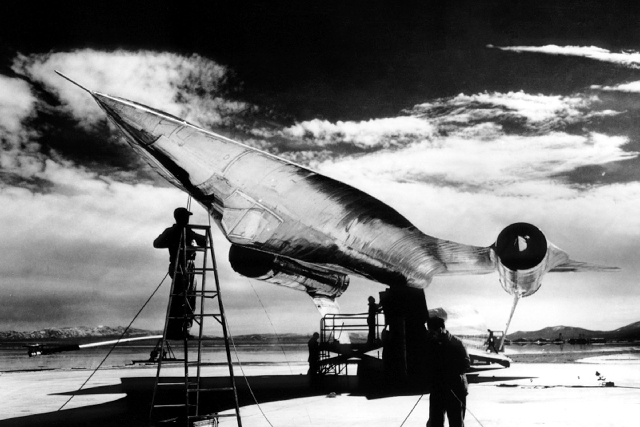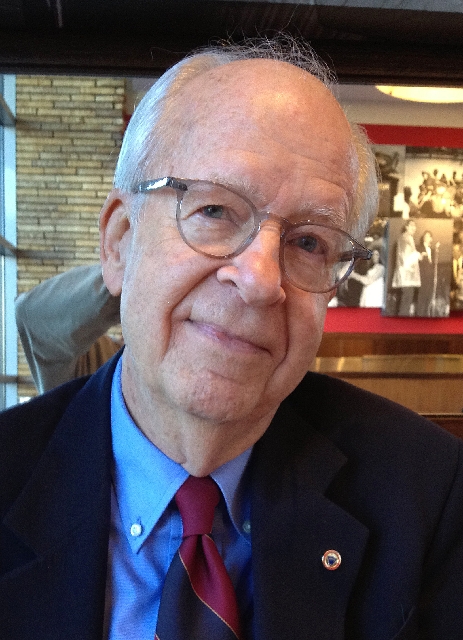Quiet arms race continues, retired CIA officer says


Eugene Poteat is a living piece of Cold War history, and the 83-year-old retired CIA senior scientific intelligence officer believes the conflict is still under way.
“It just went underground” and continues to simmer beneath the friendly atmosphere portrayed today by leaders of the United States and Russia.
He said so in an hourlong interview before speaking to the Las Vegas chapter of the Association of Former Intelligence Officers and military colleagues at the Nellis Air Force Base Officers Club in late February.
The president of the 5,000-member association of former spooks was in Las Vegas on “a simple mission,” he said, one much different from the mind-boggling, covert activities of a career that included operations at Area 51 during the “high-water mark” of the Cold War in the early 1960s.
“We want to educate the public on the critical role that our intelligence community plays in our national security,” said Poteat, a recipient of the CIA’s Medal of Merit and the National Reconnaissance Office’s Meritorious Civilian Award for technological innovation.
‘THE RESET BUTTON’
Poteat said the Cold War’s zenith was the 1962 Cuban missile crisis, when President John F. Kennedy defused the threat of a Soviet nuclear attack two weeks before missiles could be installed in Cuba, just 90 miles from Florida.
Less well known is the high-stakes game of scientific and political brinkmanship between the superpowers that started in the 1950s. Poteat said that quiet arms race continues today despite claims by historians that the Cold War ended when the Berlin Wall fell in late 1989.
“The Cold War did not end at all. Never did. It just went underground,” he said. “The (former) Soviets have more spies in Washington than during the bloody Cold War, and everybody else has more here as well. You can talk about China and others.”
In his words, President Barack “Obama pushed the reset button. He thinks it’s over. It’s not over by a long shot.”
“They (Russian scientists) continue to improve their nuclear weapons systems and they’re very effective,” he said. “Their missiles are bigger and better and as accurate as ours. They’ve got more of them.”
STEALTH PIONEER
Poteat knows his subject well. He was there when the CIA turned to science to supplement age-old methods of learning more about an adversary.
Poteat pioneered development of the first radar-evading or stealthy aircraft, the A-12 Oxcart at Area 51. He also helped prove the capabilities of the high-flying U-2 spy plane, which provided Kennedy with photographic evidence that Soviet Premier Nikita Khrushchev was making it possible for nuclear missiles from Cuba to strike New York and Washington, D.C.
“He was sneaking missiles into Cuba, where they had short-range missiles by the hundreds,” Poteat recalled. “It was probably the world’s biggest and boldest covert operation conducted by the Soviet Union.
“He had so many nuclear weapons going into Cuba, the island would glow in the dark. You could see it from Key West.
“The Cuban missile crisis was the high-water mark of the Cold War,” he said. “Before that the Soviet Union was very aggressively trying to push their communism on the world but there was only one thing to stop them: the U.S.
“They were making considerable progress. They had already stolen every single secret the U.S. had to the extent (Joseph) Stalin knew about the American atomic bomb before President (Harry) Truman. That’s how effective their intelligence was, and we had zero intelligence about them.”
SCIENTIFIC BOOST
An electrical engineer and physicist, Poteat joined the CIA’s Office of Scientific Intelligence in 1959. He went on to serve in the Directorate of Science and Technology and the National Reconnaissance Office, and was technical director of the Navy’s Special Programs Office.
During the early 1960s he worked at Area 51, the classified installation 90 miles north of Las Vegas, testing the abilities of high-tech U.S. aircraft against Soviet radar.
The complex of hangars and a lengthy runway along the Groom Dry Lake bed became ground zero in the Cold War as the United States launched an effort based on “national technical means” to counter the communists’ advantage in human spies.
The CIA’s scientists learned so much about the Soviet Union’s radar that they could even make their adversaries see things that weren’t there.
“We built a spoofing device that could send an electronic ‘airplane’ into Soviet radar,’’ he explained. “We could change the size of that electronic target to make it as big as a B-52 bomber or as small as a bird, and anything in between.”
In a 1999 paper, “Engineering in the CIA,” Poteat described a Project Palladium test of Havana’s Soviet-made air defense system that was so convincing it made a Cuban fighter pilot see things that were never there.
“We had no trouble in manipulating the Palladium system controls to keep our ghost aircraft just ahead of the pursuing Cuban fighters. … (We) heard the Cuban pilot radio his controllers that he had the intruding aircraft in sight and was about to make a firing pass to shoot it down …”
No shots were fired, though. A CIA engineer shut down the system, making the intruder vanish.
EFFECT OF INTELLIGENCE
At Area 51’s outdoor laboratory, scientists would hone the shape, color and materials for spy planes such as the A-12 to reduce its radar signature by as much as 90 percent. They mounted models of aircraft on poles and towers to make cross-sectional assessments of their radar signatures.
“They took a full-size airplane and turned it upside down on a spike and tilted it over, the whole airplane. Then we had ground-based radars over here to see how to minimize the signature,” Poteat said.
Evidence collected by CIA spy planes was critical in ending the Cuban missile crisis, Poteat said.
Reconnaissance photos of missile launch sites in Cuba, combined with technical data collected by agents on the ground in the Soviet Union, gave Kennedy definitive information that guided efforts to avert a nuclear exchange, Poteat explained.
“The Cold War never got fought for a reason,” Poteat said. “I think that knowledge that came from intelligence kept the Cold War from getting hot.”
But it’s heating up again, Poteat said, pointing to a recent international incident that he considers an example of Russia’s continuing Cold War mentality, the 2010 crash near Smolensk, Russia, of a Tu-154 jetliner that killed Polish President Lech Kaczynski and 95 other top government officials.
Poteat said investigators found traces of explosives in the wreckage, an indication that Russian officials might have conspired to cause the crash.
Though a joint Russian-Polish investigation later found no foul play, Poteat stands his ground.
“If you know the murderous history of the Soviets and communists, that’s how they solve their problems,” he said.
Contact reporter Keith Rogers at
krogers@reviewjournal.com or 702-383-0308.












